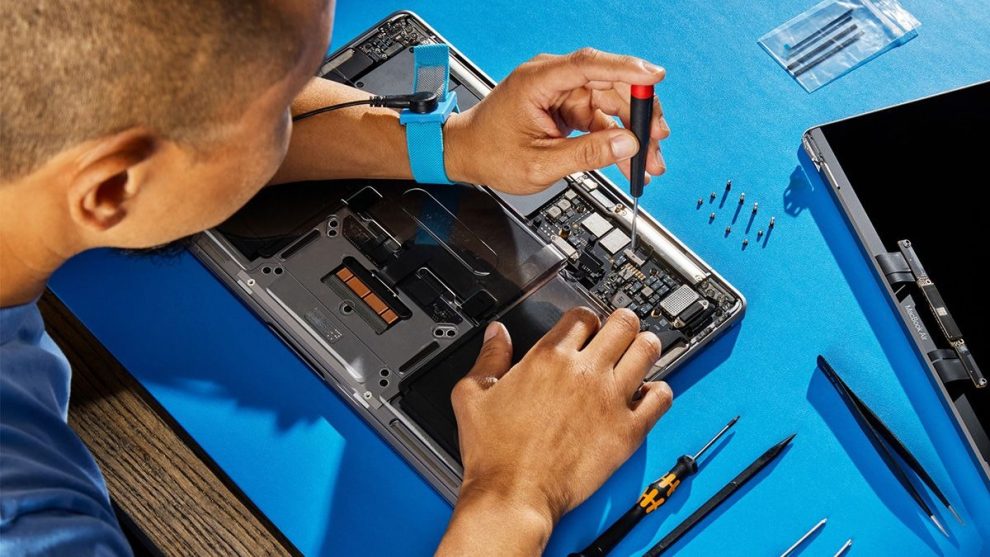The “Right to Repair” movement aims to empower consumers to fix their own devices or choose independent repair shops, but identifying gadgets that actively support this movement can be tricky. Here are some steps you can take:
1. Check Manufacturer Statements
Visit the official website of the device manufacturer and search for their Right to Repair stance. Some companies, like Fairphone and iFixit, explicitly support repairability, while others might not offer any information.
2. Look for Repairability Scores
Organizations like iFixit offer repairability scores based on factors like availability of spare parts, repair manuals, and ease of disassembly. Higher scores indicate devices designed with repair in mind.
3. Consult Online Resources
Websites like Repair.org and Right to Repair track legislation and manufacturer practices related to repairability. They may provide lists of repairable gadgets or resources to help you research specific models.
4. Clues in Design
Look for devices with easily removable screws, modular components, and readily available replacement parts. Avoid gadgets glued shut or requiring specialized tools for disassembly.
5. Investigate Third-Party Repair Options
Check if independent repair shops can easily obtain parts and service manuals for the device you’re interested in. This indicates a more open repair ecosystem.
6. Consider Right to Repair Legislation
Some countries and regions have passed Right to Repair laws requiring manufacturers to provide spare parts and manuals. Research existing legislation in your area to understand your rights and available options.
7. Remember, it’s an Evolving Landscape
The Right to Repair movement is still gaining momentum, and manufacturer practices are constantly evolving. Stay updated on new developments and legislation to make informed choices.
Additional Tips
- Look for brands known for their commitment to sustainability and repairability.
- Read online reviews and forums to see if other users have successfully repaired the device themselves.
- Consider the total cost of ownership, including potential repair costs, when making your decision.
By utilizing these strategies, you can become a more informed consumer and choose gadgets that align with your values and empower you to repair them when needed. Remember, the Right to Repair is an ongoing fight, and your informed choices can contribute to a more sustainable and user-centric future for technology.
[Content Word Count: 479]The “Right to Repair” movement has gained significant momentum over the past few years, advocating for laws and policies that give consumers and independent repair technicians access to the parts, tools, diagnostics and manuals needed to repair modern electronic gadgets. Currently, manufacturers impose various restrictions that can make repair difficult, impossible or unaffordable – but identifying gadgets that actively embrace repairability can be an uphill task for most consumers.
This comprehensive guide takes you through the key steps needed to determine if that shiny new phone, laptop, tablet, game console or appliance you’re eyeing will empower you to fix it yourself or take it to a local repair shop when it eventually breaks down.
Step 1: Research Manufacturer Support for Right to Repair
The first step is to proactively look up the stance of gadget manufacturers and brands on enabling repair access and repairability. A quick visit to their website or a targeted online search can reveal if they have made any public commitments to supporting the consumer’s right to repair.
Manufacturers like Apple have vocally opposed right to repair legislation, claiming safety and intellectual property concerns. In contrast, brands like Framework actively champion repairability of their gadgets. Websites like iFixit maintain searchable databases where consumers can lookup right to repair scores for over 25,000 devices across thousands of brands.
While the public stance of brands provides a starting indication, further investigation is needed to ascertain if their actual product design and after-sales service policies demonstrate genuine repairability.
Step 2: Analyze Product Repairability Scores
Independent organizations like iFixit conduct gadget teardowns and offer detailed repairability ratings across a dozen weighted criteria from ease of disassembly to availability of repair documentation. Consumers can consult these ratings for the specific product variant and generation they intend to purchase to better understand serviceability prospects.
For instance – the Fairphone 4 scores an impressive 10/10 in disassembly convenience, compared to a 6/10 for the iPhone 13 Mini. For laptops, the Framework Laptop leads with 9/10 while Dell XPS models average around 5-7/10. Beyond just phones and laptops, iFixit repairability scoring covers game consoles, appliances, tablets, scooters and more.
It’s important to note however, that not all devices have published repair scores. For unrated products, move onto other evaluation criteria discussed further.
Step 3: Investigate Ease of Access to Spare Parts
Devices engineered for repair longevity and sustainability make genuine OEM and aftermarket spare parts readily available for consumers to purchase. Websites like iFixit and RepairPartsUSA allow you to search for everything from MacBook batteries to Galaxy phone screens to Nintendo Switch joysticks.
Required replacement parts that are scarce, always out-of-stock or exorbitantly priced point towards manufacturers limiting access. Pay attention to part availability spanning older generation gadgets too, as this indicates the length of serviceability support.
Step 4: Check for Diagnostics, Tools and Documentation
Access to repair manuals, diagnostics software and specialized tools is imperative for both DIY and professional third-party gadget repair – but often restricted by manufacturers. Websites like ManualsLib offer user communities that share hard-to-find documentation spanning phones, laptops, smart home devices and gaming systems.
Quality repair relies on more than just parts availability. Without wiring schematics, board layouts, diagnostic logs and even screwdriver types listed – devices cannot truly enable right to repair.
Step 5: Evaluate After Sales Service Policy
Manufacturers often actively deter third-party repair shops by restricting supply of components to “Authorized Service Providers” only. This allows them to charge inflated rates for out-of-warranty support. Consumers must scrutinize after sales repair policies to determine if alternatives to high-cost official repairs exist.
Many brands that publicly talk about sustainability provide little transparency into actual service costs for common failures like battery replacements. They also outright void warranties if any self-repair or third-party technician simply opens or services the device.
Step 6: Determine Right to Repair Law Protections
While the right to repair movement pushes for increased consumer electronics serviceability, actual legislation enforcing this is limited. As of 2023, over 25 U.S states have active or proposed right to repair bills with varying degrees of scope. The EU recently passed new right to repair regulations as well.
Consumers should research if repairability protection laws exist in their specific country or state when evaluating future serviceability. Even without hard legislation, brands responding positively to consumer pressure can drive change.
The Bottom Line
Identifying gadgets that truly embrace repairability instead of just superficial greenwashing requires research across multiple facets – manufacturer policies, product design, parts access and legal landscapes. While no device scores perfectly across all parameters, consumers have increasing transparency into making informed decisions.
There is no one-size-fits-all best gadget from a right to repair lens. Needs and priorities differ among users – whether longevity via DIY repair or affordable professional third-party shops matter more. But the key is to leverage all the metrics and resources outlined here during the purchase consideration phase.
With environmental e-waste from discarded electronics reaching dangerous levels globally, applying these repairability identification strategies allows consumers to vote with their wallet. This ultimately motivates brands to take sustainability beyond just marketing promises. The right to repair ensures usable goods stay out of landfills – and with more vigilance, that vision can gradually turn into reality.
















Add Comment